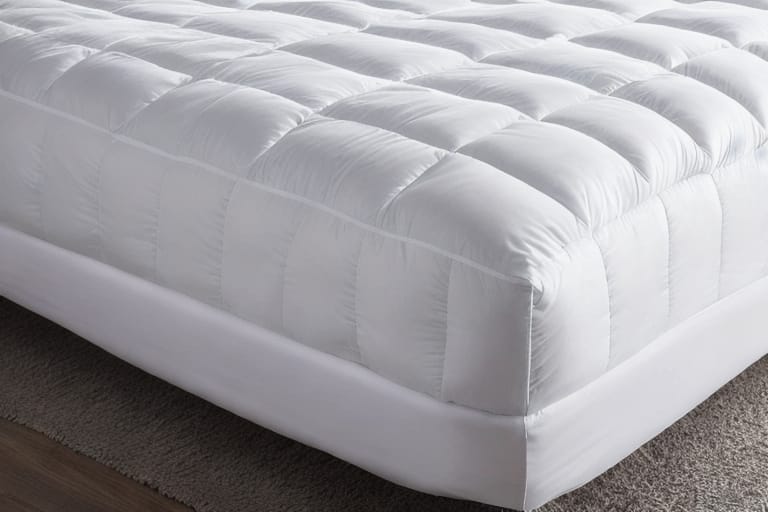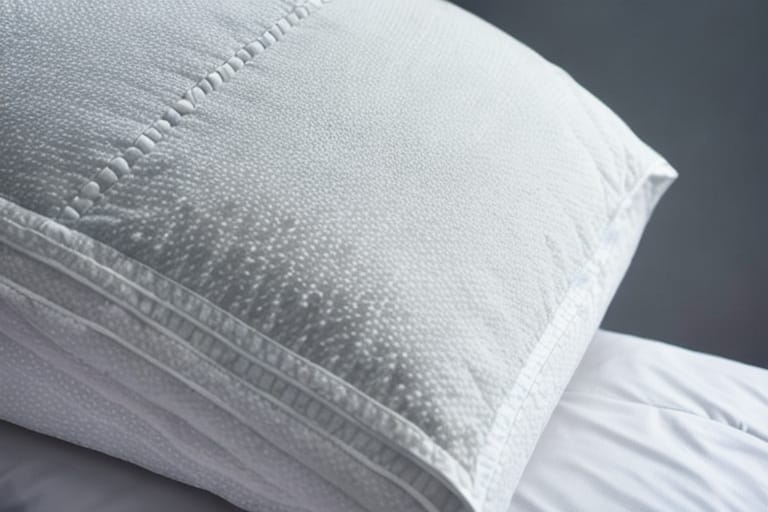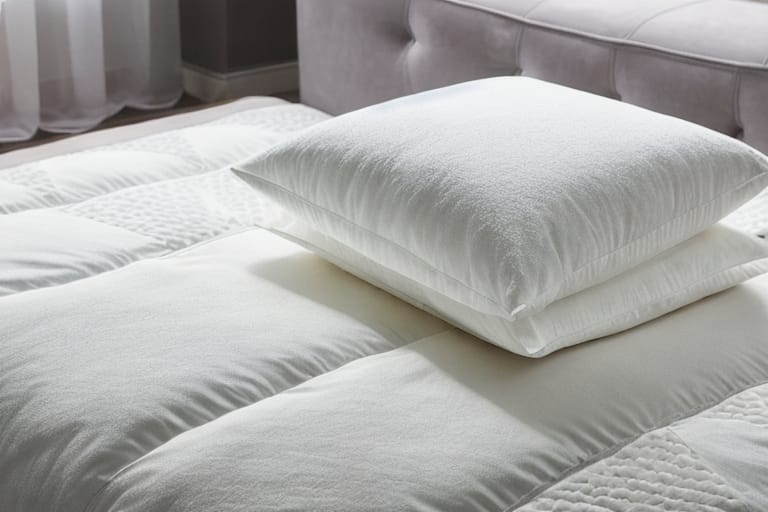When it comes to keeping warm on cold winter nights, some bedding is better than others. But what is the warmest option – a down comforter or a down alternative?
Down comforters are known for providing toasty, lightweight warmth. The fluffy fill is made from the fine, soft underplumage of ducks or geese. This natural fill creates a loft that efficiently traps body heat.
Down alternative comforters offer similar comfort at a lower price point and decreased allergy risk. They use various synthetic fills to mimic the qualities of natural down. But there are key differences in warmth and performance.
This guide examines how down and down alternatives compare for temperature regulation, insulation, breathability, and beyond. Read on to learn which fill excels for warmth, so you can make an informed choice suitable for your climate and sleeping needs.
What Is a Down Comforter?
A down comforter contains a fill made from the delicate undercoat of ducks and geese underneath their exterior feathers. This fluffy fill material clusters together to create height and insulation power.
- Fill power indicates the loft and insulation quality of down. Higher fill down will trap more air. Premium down comforters start at 600 fill power.
- Popular varieties of down include goose down, known for resilience and warming effectiveness, and duck down, which is affordable yet still insulating.
Down offers unmatched heat retention thanks to its unique structure. The soft, three-dimensional clusters interlock to form pockets that efficiently trap body heat. This creates a lightweight, breathable warmth ideal for cold weather.
What Is a Down Alternative Comforter?
A down alternative comforter uses synthetic fills instead of natural goose or duck down. Materials like microfiber or polyester mimic certain qualities of down, providing insulation and comfort at an affordable price while avoiding animal products.
- Synthetic fills come in various forms including balls, clusters and vertical side-by-side fibers to replicate down properties.
- Brand names for common down alternatives include PrimaLoft and Thermolofter.
The polyester fills often have silicon applied to fibers to increase fluff and height. This creates warming dead air space similar to down, although the materials used can vary in softness, compression, and longevity.
Comparing Down and Down Alternatives for Warmth
When it comes to heat retention, fill power and quality are key. The capacity to trap air determines how much body heat can be captured inside the comforter instead of dissipating into the room.
Thermal Efficiency
Down is highly efficient at retaining warmth. The soft, three-dimensional structure clusters closely together with plenty of lofts to effectively trap body heat.
With more dead air space inside, less warmth can escape. Higher fill power down between 600 to 900 fill creates the most efficient insulation.
Down alternatives mimic these heat-trapping air pockets through polyester fibers, balls, or other synthetic fills quilted into channels. Initially, they can feel similar to down.
However, the materials tend to be less breathable and the fills can shift during washing. Over time resiliency and insulation ability may decrease.
Temperature Regulation
Both down and down alternative comforters feel wonderfully lightweight, unlike blankets or wool covers that can feel heavy and restrictive.
True, high-quality down provides the best temperature regulation thanks to its unmatched breathability. Body moisture dissipates through the down pockets instead of building up.
Down alternatives often rely on synthetic fills like crimped polyester fibers to replicate down. But these materials are typically less breathable.
There is greater risk of overheating, making down alternatives better suited for moderately cool rather than very cold climates. The synthetic fills don’t adjust as effectively to temperature changes throughout the night.
Down vs. Down Alternative Comforters
| Feature | Down Comforter | Down Alternative Comforter |
|---|---|---|
| Fill Material | Goose or duck down | Polyester, microfiber or rayon |
| Warmth | Excellent – traps air efficiently | Very good – mimics down qualities |
| Fill Power | 600 and higher | N/A |
| Durability | Often lasts over 10 years | Varies by quality – lower longevity |
| Breathability | Excellent | Moderate |
| Allergies | Contains animal product which can trigger allergies or sensitivities | Hypoallergenic synthetic materials better for allergies |
| Price | Mid-range to luxury – $200+ | Budget to mid-range – $50 to $150+ |
| Maintenance | Professional cleaning recommended every few years | Machine washable more often |

Factors That Impact Warmth
Comforters need loft and fill power to hold in heat. But warmth also depends on the sleeper, bedroom, and quality of construction. Here are factors that influence heat retention in any comforter.
Fill Power
For down comforters, fill power measures fluffiness and insulation. Higher numbers like 700+ fill represent finer, lighter clusters that trap air exceptionally well. Lower fill power around 500 is heavier, creating less loft and air space for retaining body heat.
Down alternative synthetic fills cannot be measured by fill power. Check product details instead for materials used, ounce weight, and any warmth ratings or guidelines that indicate heating efficiency.
Insulation Ability
Warmth relies heavily on insulation capacity, regardless of fill material. Cluster formation enables capturing pockets of air, while materials like eiderdown and certain synthetic fills increase height and dead air space.
Baffle box or sewn-through stitching impacts insulation uniformity across the comforter. Cold spots can develop where fills shift or become compressed. Finally, shell materials affect permeability – cotton, for example, is more breathable than microfiber.
Determining the Warmer Option
When comparing down comforters and down alternative comforters, the key factor that makes down warmer is its superior breathability and longevity.
Light, fluffy goose down efficiently traps body heat while allowing water vapor to pass through. The insulation lasts through years of use.
While synthetic alternatives initially mimic the warmth, heat retention tends to degrade sooner. The artificial fills absorb more moisture and hold heat less efficiently over time.
For cozy wintertime warmth, natural down is the best insulator. Premium down comforters with 600+ fill power create the most breathable heat, perfect for cold weather climates or chilly sleepers wanting lightweight comfort. The investment pays dividends in enduring performance.
Those prone to allergies or wanting budget bedding may prefer a down alternative. Just expect to layer on more blankets as the seasons grow colder.
Down Fill Types and Cluster Formation
Down fill consists of the ultra-soft, fluffy clusters and feathers closest to a bird’s skin, underneath the exterior feathers and plumage. This delicate undercoat provides insulation against wet, cold conditions.
Popular down comforter options include:
- Goose down – Large, resilient clusters that are highly insulating
- Duck down – More affordable, good clusters still provide warmth
- Eiderdown – Rare, small and lightweight; premium insulation
Down cluster structure impacts loft, fill power, and durability. The soft inner plumules interlock to capture air pockets. Larger outer plumules add volume and support around the delicate fine centers.
Higher fill power down has a higher percentage of fine inner plumules. Smaller clusters with more dead air space inside create the highest quality insulation.
Down Alternative Fibers and Fills
While natural down comes from duck and geese, the raw materials that makeup down alternatives are synthetically produced.
There are two main types used:
- Fibers – Microfibers, typically made of polyethylene or polyester, with a fine denier to replicate down. PrimaLoft is a common brand.
- Fills – Polyester balls, chips or other cluster shapes that mimic down pockets to trap air. These vary more in quality and longevity.
Other aspects that impact performance are fiber height, thickness and application of silicone for increased fluffiness. Better down alternatives approach the warmth, feel and longevity of natural down.
Outer Shell Fabric Matters Too
Along with high-quality fill and proper cluster formation, the outer shell plays a role in comforter construction and effectiveness.
Materials like cotton, cotton sateen, or camlet cotton offer breathability. These woven fabric exteriors allow bodily moisture to pass through, rather than trapping heat and sweat next to your body.
Other shells like microfiber or nylon are finely woven synthetics that resist permeability. Great for outdoor equipment, but retaining more heat indoors.
Finally, thread count impacts softness and durability. Higher thread counts over 200 or more create smoother, more snag-resistant fabric with enhanced ventilation.
Caring for Down Comforters
One concern with a premium down comforter investment is proper maintenance. But a little care goes a long way.
- Professional cleaning every 2-3 years replenishes loft and insulation
- Frequent spot cleaning when needed
- Low heat tumble dry and fluff to revive clusters
- Use a duvet cover to protect the comforter
With care a high-quality down comforter should last over a decade before loses resilience or fill power. This makes the longevity worth the larger upfront expenditure over time.
Cleaning and Caring for Down Alternative Items
A major perk of down alternative comforters, toppers, jackets and more is convenient care. Most are machine washable and dryable at home.
Check label instructions but washing a couple of times a year revives insulation and prevents the buildup of oils, sweat and other grime that can degrade synthetic materials. More frequent laundering may damage lower quality fills.
Tumble dry low and remove promptly to prevent clumping. Budget down alternative bedding tends to last 2-5 years with regular use before losing loft and warmth. Higher quality down mimics can approach the longevity of down with proper maintenance.
The Responsible Down Standard (RDS)
Animal welfare is a top consideration. Thankfully the textile industry set standards through the Responsible Down Standard (RDS) for ethical treatment of ducks and geese.
RDS certification traces supply chains ensuring humane practices from farm to finished comforter fill:
- No live plucking or force feeding
- Freedom to roam with access to clean food, water and sheltered spaces
- Third party audited for animal wellbeing
All major manufacturers and most bedding brands use RDS certified down. This includes big names like The Company Store, Eastman House, and Eastern Accents along with direct to consumer brands like Parachute Home and Brooklinen.
Seeking RDS certification ensures your down comes from ethically raised fowl. Another option is recycled or repurposed although availability is limited.

Additional Considerations When Choosing
Beyond warmth, costs and ethical factors, personal preferences matter too. Consider aspects like:
- Desired weight and feel – Light and airy or a heavier dual layer
- Aesthetics to match room decor – White, colors or print pattern
- Seasons of use – Year-round comforter or dedicated winter bedding
- Size for mattress and bedrooms – King to twin and anything in between
A few top rated options include:
| Down Comforter | Price | Rating |
|---|---|---|
| Brooklinen Down Comforter | $249+ | ⭐⭐⭐⭐⭐ |
| Buffy Cloud Down Comforter | $170+ | ⭐⭐⭐⭐⭆ |
| The Company Store LaCross Duvet Insert | $255+ | ⭐⭐⭐⭐ |
| Down Alternative Comforter | Price | Rating |
|---|---|---|
| Amazon Basics Reversible Poly Comforter | $47+ | ⭐⭐⭐⭐ |
| Linenspa All-Season Alternative Quilted Comforter | $30+ | ⭐⭐⭐⭆ |
| Everything Home by Clara Clark 1200 Thread Count | $67+ | ⭐⭐⭐⭆ |
No matter your budget, personal preferences, climate or primary goal for great sleep, hopefully this guide provided you helpful insights so you can decide whether a down comforter or down alternative better meets your needs.
Both offer enjoyable lightweight warmth important for restful sleep. But down comforters excel at enduring breathable heat thanks to unbeatable cluster structure trapping air. For those not bothered by cost or allergens they make a worthy winter bedding investment that outlasts cheaper synthetic competitors.
Frequently Asked Questions
Is a down comforter warmer than a down alternative?
Yes, down comforters made with a high fill power goose down or duck down fill provide exceptional warmth that can’t quite be matched by down alternatives. The unique three-dimensional structure of down efficiently traps air to retain body heat. Synthetic fills come close and are warmer than other blankets or comforters, but true premium down offers the highest degree of insulating power and breathability.
How do I know if a down comforter will keep me warm enough?
Check the fill power, which measures the loft and quality of the goose or duck down. Any down comforter with over 600 fill power will provide excellent warmth, while 800+ fill power is ultra-premium. Also look for baffle box construction that prevents cold spots and a higher thread count cotton cover that allows internal moisture to pass through the breathable shell.
Why might someone choose a down alternative comforter instead of down?
There are a few key reasons to select a down alternative comforter:
- Cost savings – Synthetic options are more budget-friendly
- Convenience – Most are machine washable and easier to maintain
- Hypoallergenic properties – Synthetic fills like microfiber avoid triggers from natural materials and animal products
- Environmental factors – Vegan materials or options made from recycled PET bottles appeal to some buyers
While synthetic comforters don’t tend to be quite as warm, breathable or durable long-term, they still provide good comfort and insulation at an affordable price point for shoppers with sensitivities.
How often should you replace a down comforter?
With proper care like dry cleaning every 2 to 3 years, an high quality down comforter should last over a decade before losing significant fill power. Fluffing the comforter occasionally as needed between professional cleaning helps revive the insulating down clusters. If stored properly in a breathable space during warmer months, it’s not unusual for the best down comforters to last 15 years or more before needing replacement.
What’s the warmest and most comfortable down alternative?
When searching for the coziest down alternative comforter that truly rivals natural down, pay attention to the fill material and shell fabric. PrimaLoft and microfiber blends often offer good resilience and longevity. For the cover, a breathable sateen cotton with a thread count over 200 feels softer and allows better airflow. Finally, look for materials and certifications showing sustainable sourcing for peace of mind that the comforter was produced responsibly.








